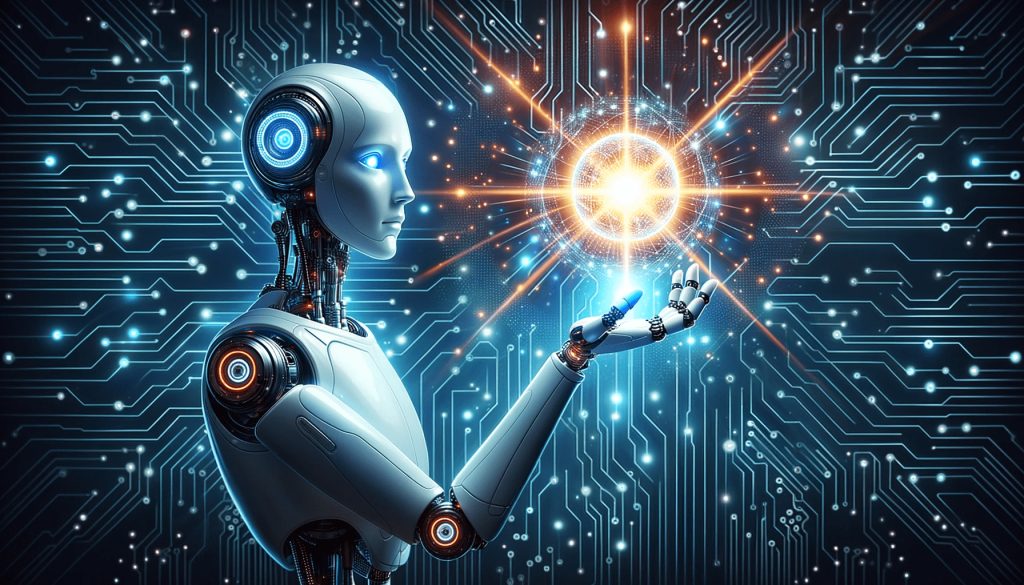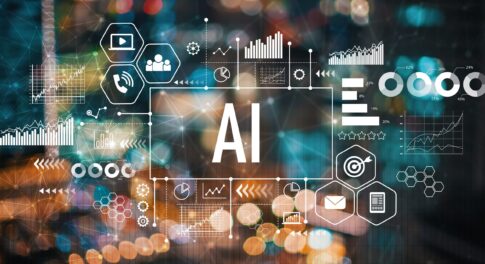人工知能(AI)と機械学習について、日本語と英語で学ぶための基本的な情報とキーフレーズを提供します。これにより、AIと機械学習の概念を両方の言語で理解しやすくなります。
人工知能(AI)と機械学習の基本概念
1. 人工知能(AI: Artificial Intelligence)
- 日本語: 人工知能(AI)は、人間の知能を模倣するコンピュータシステムです。学習、推論、自己修正などの能力を持ちます。
- 英語: Artificial Intelligence (AI) refers to computer systems that mimic human intelligence. It involves capabilities such as learning, reasoning, and self-correction.
2. 機械学習(ML: Machine Learning)
- 日本語: 機械学習(ML)は、データからパターンや知識を学び、経験を基に予測や判断を行う技術です。AIの一分野です。
- 英語: Machine Learning (ML) is a technology that learns patterns and knowledge from data to make predictions or decisions based on experience. It is a subset of AI.
キーフレーズ
1. 基本的な用語(Basic Terminology)
- 日本語:
- 「アルゴリズム」: データを処理するための手順や計算方法。
- 「ニューラルネットワーク」: 人間の脳の構造を模倣したAIのモデル。
- 「データセット」: 機械学習モデルの訓練に使用するデータの集合。
- 英語:
- “Algorithm”: A set of rules or calculations used to process data.
- “Neural Network”: An AI model that mimics the structure of the human brain.
- “Dataset”: A collection of data used to train machine learning models.
2. 機械学習のプロセス(Machine Learning Process)
- 日本語:
- 「モデルの訓練」: データを使って機械学習モデルを学習させるプロセス。
- 「検証」: モデルの精度を確認するためにデータを使用するプロセス。
- 「予測」: 訓練されたモデルを使って新しいデータに対して予測を行うプロセス。
- 英語:
- “Model Training”: The process of teaching a machine learning model using data.
- “Validation”: The process of using data to check the accuracy of a model.
- “Prediction”: Using a trained model to make predictions on new data.
3. AIとMLの応用(Applications of AI and ML)
- 日本語:
- 「音声認識」: 音声をテキストに変換する技術。
- 「画像認識」: 画像内の物体やパターンを識別する技術。
- 「自然言語処理(NLP)」: 人間の言語を理解し処理する技術。
- 英語:
- “Speech Recognition”: Technology that converts spoken language into text.
- “Image Recognition”: Technology that identifies objects or patterns within images.
- “Natural Language Processing (NLP)”: Technology that understands and processes human language.
参考情報(Additional Resources)
1. 学習リソース(Learning Resources)
- 日本語:
- 「AIと機械学習入門」: 書籍やオンラインコースでの基礎学習。
- 「データサイエンス」: AIやMLを使ったデータ解析技術を学ぶリソース。
- 英語:
- “Introduction to AI and Machine Learning”: Books and online courses for foundational learning.
- “Data Science”: Resources for learning data analysis techniques using AI and ML.
2. おすすめのツール(Recommended Tools)
- 日本語:
- 「TensorFlow」: Googleが提供する機械学習ライブラリ。
- 「PyTorch」: Facebookが提供する深層学習ライブラリ。
- 英語:
- “TensorFlow”: A machine learning library provided by Google.
- “PyTorch”: A deep learning library provided by Facebook.
これらの情報を使って、AIと機械学習の基本的な理解を深め、実際の応用にもつなげていくことができます。
AI(人工知能)とML(機械学習)についてもっと学ぼう!
AI(人工知能)とML(機械学習)についてさらに詳しく掘り下げてみましょう。以下は、それぞれの技術の主要な側面と具体的なトピックです。
人工知能(AI: Artificial Intelligence)
1. AIの種類(Types of AI)
- 日本語:
- 「狭義のAI(Narrow AI)」: 特定のタスクに特化したAI。例:音声アシスタントやチャットボット。
- 「一般AI(General AI)」: 人間のように幅広いタスクをこなせるAI。現在の技術では実現していない。
- 「超知能AI(Superintelligent AI)」: 人間を超える知能を持つAI。理論上の存在で、倫理的な議論の対象。
- 英語:
- “Narrow AI”: AI specialized in a specific task. Example: voice assistants or chatbots.
- “General AI”: AI capable of performing a wide range of tasks like a human. Not yet realized with current technology.
- “Superintelligent AI”: AI that surpasses human intelligence. A theoretical concept with ethical discussions.
2. AIの技術(AI Technologies)
- 日本語:
- 「ルールベースシステム」: 明確なルールに基づいて動作するAI。例:エキスパートシステム。
- 「深層学習(Deep Learning)」: ニューラルネットワークを使った学習方法。特に大量のデータから特徴を自動的に抽出する能力があります。
- 英語:
- “Rule-Based Systems”: AI that operates based on explicit rules. Example: expert systems.
- “Deep Learning”: A method of learning using neural networks, particularly effective in automatically extracting features from large datasets.
機械学習(ML: Machine Learning)
1. 機械学習の種類(Types of Machine Learning)
- 日本語:
- 「教師あり学習(Supervised Learning)」: ラベル付きデータを使ってモデルを訓練する方法。例:分類問題や回帰問題。
- 「教師なし学習(Unsupervised Learning)」: ラベルなしデータを使ってデータのパターンや構造を発見する方法。例:クラスタリングや次元削減。
- 「強化学習(Reinforcement Learning)」: 環境とインタラクションしながら最適な行動を学習する方法。例:ゲームプレイやロボット制御。
- 英語:
- “Supervised Learning”: A method of training models using labeled data. Example: classification problems or regression problems.
- “Unsupervised Learning”: A method of discovering patterns or structures in unlabeled data. Example: clustering or dimensionality reduction.
- “Reinforcement Learning”: A method where an agent learns optimal actions through interactions with an environment. Example: game playing or robot control.
2. 機械学習のアルゴリズム(Machine Learning Algorithms)
- 日本語:
- 「線形回帰(Linear Regression)」: 連続的な値を予測するためのアルゴリズム。
- 「決定木(Decision Trees)」: データの条件に基づいて決定を下すアルゴリズム。
- 「サポートベクターマシン(SVM)」: データをクラスに分けるためのアルゴリズム。
- 英語:
- “Linear Regression”: An algorithm for predicting continuous values.
- “Decision Trees”: An algorithm for making decisions based on data conditions.
- “Support Vector Machines (SVM)”: An algorithm for classifying data into different classes.
AIと機械学習の活用例(Applications of AI and Machine Learning)
1. 健康管理(Healthcare)
- 日本語:
- 「画像診断」: CTスキャンやMRI画像から病変を検出する技術。
- 「個別化医療」: 患者の遺伝情報に基づく治療法の提案。
- 英語:
- “Image Diagnostics”: Technology for detecting abnormalities in CT scans or MRI images.
- “Personalized Medicine”: Treatment recommendations based on a patient’s genetic information.
2. 顧客サービス(Customer Service)
- 日本語:
- 「チャットボット」: 顧客の質問に自動で応答するシステム。
- 「感情分析」: 顧客のフィードバックやレビューから感情を分析する技術。
- 英語:
- “Chatbots”: Systems that automatically respond to customer inquiries.
- “Sentiment Analysis”: Technology for analyzing emotions from customer feedback or reviews.
3. 金融(Finance)
- 日本語:
- 「リスク評価」: 顧客の信用リスクを評価するためのモデル。
- 「アルゴリズムトレーディング」: 自動で株式取引を行うシステム。
- 英語:
- “Risk Assessment”: Models for evaluating a customer’s credit risk.
- “Algorithmic Trading”: Systems for automatically executing stock trades.
4. 交通(Transportation)
- 日本語:
- 「自動運転車」: AIを使って自動で運転する車両。
- 「交通渋滞予測」: リアルタイムで交通状況を予測する技術。
- 英語:
- “Autonomous Vehicles”: Vehicles that drive themselves using AI.
- “Traffic Congestion Prediction”: Technology for predicting real-time traffic conditions.
これらの情報を使って、AIと機械学習の理解をさらに深めることができます。基本的な概念から応用まで、広範な知識を得ることで、これらの技術がどのように現実世界で活用されているかを理解できるでしょう。
AI(人工知能)とML(機械学習)の今後の展望について
AI(人工知能)とML(機械学習)の今後の展望について、日本語と英語で詳しく説明します。
AI(人工知能)とML(機械学習)の今後の展望
1. より高度な自動化(Advanced Automation)
- 日本語: AIと機械学習は、さらに多くの業務やプロセスの自動化を進めるでしょう。これにより、製造業、物流、カスタマーサービスなどの分野での効率が向上し、人間がより創造的な仕事に集中できるようになります。特に、複雑な判断や予測が必要な領域での自動化が進むと考えられます。
- 英語: AI and machine learning are expected to advance the automation of more business processes and tasks. This will enhance efficiency in fields like manufacturing, logistics, and customer service, allowing humans to focus on more creative work. Automation is likely to progress particularly in areas requiring complex decision-making and forecasting.
2. AIの倫理と規制(AI Ethics and Regulation)
- 日本語: AIの利用が拡大する中で、倫理的な問題や規制の必要性が高まっています。プライバシー保護、バイアスの排除、安全性の確保などの課題に対処するため、規制やガイドラインの整備が進むでしょう。AIの公平性や透明性を確保するための取り組みが重要になります。
- 英語: As AI use expands, the need for ethical considerations and regulations is increasing. There will be efforts to establish regulations and guidelines to address issues such as privacy protection, bias elimination, and safety. Ensuring fairness and transparency in AI will become a crucial focus.
3. AIの統合とインタラクション(Integration and Interaction of AI)
- 日本語: AIはますます多くの分野に統合され、異なる技術との相互作用が進むでしょう。例えば、AIとIoT(モノのインターネット)、VR(バーチャルリアリティ)、AR(拡張現実)の統合が進み、よりインタラクティブでスマートな体験が提供されると予想されます。
- 英語: AI will increasingly integrate into various fields, with interactions among different technologies advancing. For instance, integration of AI with IoT (Internet of Things), VR (Virtual Reality), and AR (Augmented Reality) is expected, providing more interactive and intelligent experiences.
4. パーソナライズの進化(Evolution of Personalization)
- 日本語: AIと機械学習は、より高度なパーソナライズを実現するでしょう。ユーザーの好みや行動に基づいた個別化されたコンテンツやサービスの提供が進むことで、より一層の顧客満足度向上が期待されます。特に、マーケティングや教育、健康管理の分野での応用が進むと見込まれます。
- 英語: AI and machine learning are expected to achieve more advanced levels of personalization. By providing individualized content and services based on user preferences and behaviors, customer satisfaction is expected to improve further. Applications are anticipated to progress particularly in marketing, education, and healthcare.
5. AIの創造性(Creativity of AI)
- 日本語: AIの創造性が注目されています。例えば、AIが音楽やアートの創作に使用されるケースが増えてきています。今後、AIがさらに創造的なプロジェクトに参加し、芸術やメディアの分野で新しい表現方法を提供することが期待されます。
- 英語: The creativity of AI is gaining attention. For example, AI is increasingly used in creating music and art. In the future, AI is expected to participate in more creative projects and offer new forms of expression in the fields of art and media.
6. スマートシティとインフラ(Smart Cities and Infrastructure)
- 日本語: AIと機械学習は、スマートシティの実現に向けて重要な役割を果たします。交通管理、エネルギー効率、公共サービスの改善など、都市インフラの最適化が進むでしょう。データ分析に基づく意思決定が、より持続可能で効率的な都市づくりを支援します。
- 英語: AI and machine learning will play a crucial role in the realization of smart cities. Optimization of urban infrastructure, such as traffic management, energy efficiency, and public services, will progress. Data-driven decision-making will support the creation of more sustainable and efficient cities.
7. インターネットセキュリティの強化(Enhancement of Internet Security)
- 日本語: サイバーセキュリティの分野で、AIと機械学習が重要な役割を果たします。サイバー攻撃の検出や防御において、AIの高度な分析能力が活用されるでしょう。リアルタイムでの脅威検出や対応が進むことで、安全性の向上が期待されます。
- 英語: In the field of cybersecurity, AI and machine learning will play a crucial role. Advanced analytical capabilities of AI will be utilized for detecting and defending against cyberattacks. Enhanced real-time threat detection and response are expected to improve overall security.
これらの展望により、AIと機械学習は未来の社会やビジネスにおいてますます重要な役割を果たすことが期待されます。技術の進化とともに、新たな機会や課題が生まれるでしょう。








人工知能(AI)と機械学習